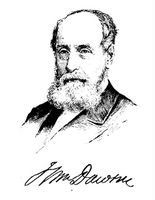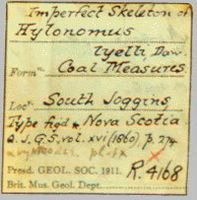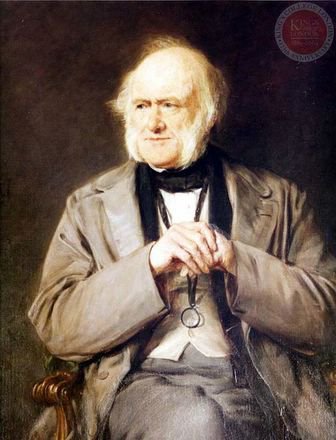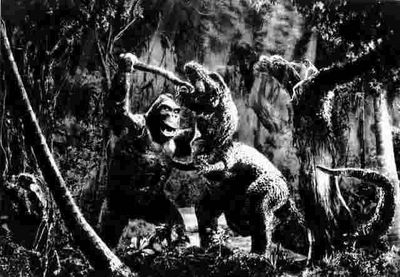A new basal ornithopod dinosaur (Frenchman Formation, Saskatchewan, Canada), and implications for late Maastrichtian ornithischian diversity in North America. 2011. Brown, C.M., et al. Zoological Journal of the Linnean Society. 163: 1157-1198
Abstract [edit]: A small, articulated basal ornithopod skeleton from the Frenchman Formation (late Maastrichtian) of Saskatchewan, previously referred to the taxon Thescelosaurus, differs from both recognized species of this taxon (Thescelosaurus neglectus and Thescelosaurus garbanii). We recognize this specimen as the holotype of a new species, Thescelosaurus assiniboiensis sp. nov.
Identification of a third species of Thescelosaurus from the late Maastrichtian of North America suggests that this taxon was more diverse than previously recognized, and shows an increase in diversity from the Campanian through the late Maastrichtian, contrasting the trends seen in most other ornithischian clades.
Wednesday, November 30, 2011
Sauropod Osteoderms
Sauropod dinosaur osteoderms from the Late Cretaceous of Madagascar. 2011. K. Curry Rogers, et al. Nature Communications 2, article number:564.

Abstract: Osteoderms are bones embedded within the dermis, and are common to select members of most major tetrapod lineages. The largest known animals that bear osteoderms are members of Titanosauria, a diverse clade of sauropod dinosaurs.
Here we report on two titanosaur osteoderms recovered from the Upper Cretaceous Maevarano Formation of Madagascar. Each osteoderm was discovered in association with a partial skeleton representing a distinct ontogenetic stage of the titanosaur Rapetosaurus krausei. Combined, these specimens provide novel insights into the arrangement and function of titanosaur osteoderms.
Taphonomic data confirm that Rapetosaurus developed only limited numbers of osteoderms in its integument. The adult-sized osteoderm is the most massive integumentary skeletal element yet discovered, with an estimated volume of 9.63 litres. Uniquely, this specimen possesses an internal cavity equivalent to more than half its total volume. Large, hollow osteoderms may have functioned as mineral stores in fecund, rapidly growing titanosaurs inhabiting stressed environments.

Abstract: Osteoderms are bones embedded within the dermis, and are common to select members of most major tetrapod lineages. The largest known animals that bear osteoderms are members of Titanosauria, a diverse clade of sauropod dinosaurs.
Here we report on two titanosaur osteoderms recovered from the Upper Cretaceous Maevarano Formation of Madagascar. Each osteoderm was discovered in association with a partial skeleton representing a distinct ontogenetic stage of the titanosaur Rapetosaurus krausei. Combined, these specimens provide novel insights into the arrangement and function of titanosaur osteoderms.
Taphonomic data confirm that Rapetosaurus developed only limited numbers of osteoderms in its integument. The adult-sized osteoderm is the most massive integumentary skeletal element yet discovered, with an estimated volume of 9.63 litres. Uniquely, this specimen possesses an internal cavity equivalent to more than half its total volume. Large, hollow osteoderms may have functioned as mineral stores in fecund, rapidly growing titanosaurs inhabiting stressed environments.
Monday, November 28, 2011
A Stopmotion History of The World
Created By Kalle Mattson, Kevin Parry, and Friends. Link from Neatorama.
Thursday, November 24, 2011
Published This Day: The Origin of The Species
From Today In Science History:
In 1859, The Origin of Species by Means of Natural Selection was published in England to great acclaim. In this groundbreaking book by British naturalist Charles Darwin, he argued that species are the result of a gradual biological evolution in which nature encourages, through natural selection, the propagation of those species best suited to their environments. This book is unquestionably one of the most influential in the history of science.
In 1859, The Origin of Species by Means of Natural Selection was published in England to great acclaim. In this groundbreaking book by British naturalist Charles Darwin, he argued that species are the result of a gradual biological evolution in which nature encourages, through natural selection, the propagation of those species best suited to their environments. This book is unquestionably one of the most influential in the history of science.
Tuesday, November 22, 2011
Cuspicephalus scarfi - The 'Torydactyl'
A monofenestratan pterosaur from the Kimmeridge Clay Formation (Upper Jurassic, Kimmeridgian) of Dorset, England. 2011. D.M. Martill and S. Etches. Acta Palaeontologica Polonica, in press.

The pterosaur Cuspicephalus scarfi is named after Gerald Scarfe, the political cartoonist whose pen demonised Mrs Thatcher as a pointy nosed ‘torydactyl’. The new discovery was so-called because of its extremely long pointy head, which is most unusual for a pterosaur. The skull is 326 mm long – similar in size to a stork or heron.
The species was found by fossil collector Steve Etches in Kimmeridge Bay, Dorset. The specimen is 155 million years old from the Late Jurassic period and is the most substantial pterosaur skull to be found in the UK for nearly 200 years. It is now on display in Dorset’s Museum of Jurassic Marine Life.
Mr Scarfe said: “I'm thrilled and flattered - I never thought Mrs Thatcher would do anything for me - even if it is to be immortalized as a 155 million year old fossil". link

The pterosaur Cuspicephalus scarfi is named after Gerald Scarfe, the political cartoonist whose pen demonised Mrs Thatcher as a pointy nosed ‘torydactyl’. The new discovery was so-called because of its extremely long pointy head, which is most unusual for a pterosaur. The skull is 326 mm long – similar in size to a stork or heron.
The species was found by fossil collector Steve Etches in Kimmeridge Bay, Dorset. The specimen is 155 million years old from the Late Jurassic period and is the most substantial pterosaur skull to be found in the UK for nearly 200 years. It is now on display in Dorset’s Museum of Jurassic Marine Life.
Mr Scarfe said: “I'm thrilled and flattered - I never thought Mrs Thatcher would do anything for me - even if it is to be immortalized as a 155 million year old fossil". link
Eric Idle on Intelligent Design. Or Michael Palin on Shakespeare. Maybe Both.
Sunday, November 20, 2011
Died This Day: John William Dawson
Dawson (Oct. 30, 1820 - Nov. 20, 1899>) was a Canadian geologist who made numerous contributions to paleobotany and extended the knowledge of Canadian geology. Dawson was born and raised in Pictou, Nova Scotia, where the many sandstone and coal formations provided fertile ground for his first scientific explorations, which culminated in the publication of Acadian Geology. He made many important discoveries of fossil life, great and small. These included fossil plants, trackways of lowly invertebrates, footprints, skeletons of reptiles and amphibians, millipedes and the earliest land snails. When the famous geologist Charles Lyell visited coal deposits in Pictou, Dawson acted as his guide.
and extended the knowledge of Canadian geology. Dawson was born and raised in Pictou, Nova Scotia, where the many sandstone and coal formations provided fertile ground for his first scientific explorations, which culminated in the publication of Acadian Geology. He made many important discoveries of fossil life, great and small. These included fossil plants, trackways of lowly invertebrates, footprints, skeletons of reptiles and amphibians, millipedes and the earliest land snails. When the famous geologist Charles Lyell visited coal deposits in Pictou, Dawson acted as his guide.
In 1851, Dawson and Lyell teamed up again to examine the interiors of fossil tree trunks at Joggins, Nova Scotia. They discovered the remains of some of the earliest known reptiles, Hylonomus lyelli, along with other rare fossils, propelling this part of the world into the international spotlight.
Nova Scotia. They discovered the remains of some of the earliest known reptiles, Hylonomus lyelli, along with other rare fossils, propelling this part of the world into the international spotlight.
Dawson became principal of McGill College in Montreal in 1854, which he made into a reputable institution. He remained there, teaching geology and palaeontology and acting as librarian, until his retirement. One of his lifelong dreams was realized in 1882 when Peter Redpath gave money to McGill for the construction and establishment of a museum, naming Dawson as director. Today the Peter Redpath Museum of Natural History houses many specimens from Dawson's personal collection.
Info from HERE and HERE. Images from HERE and HERE.
 and extended the knowledge of Canadian geology. Dawson was born and raised in Pictou, Nova Scotia, where the many sandstone and coal formations provided fertile ground for his first scientific explorations, which culminated in the publication of Acadian Geology. He made many important discoveries of fossil life, great and small. These included fossil plants, trackways of lowly invertebrates, footprints, skeletons of reptiles and amphibians, millipedes and the earliest land snails. When the famous geologist Charles Lyell visited coal deposits in Pictou, Dawson acted as his guide.
and extended the knowledge of Canadian geology. Dawson was born and raised in Pictou, Nova Scotia, where the many sandstone and coal formations provided fertile ground for his first scientific explorations, which culminated in the publication of Acadian Geology. He made many important discoveries of fossil life, great and small. These included fossil plants, trackways of lowly invertebrates, footprints, skeletons of reptiles and amphibians, millipedes and the earliest land snails. When the famous geologist Charles Lyell visited coal deposits in Pictou, Dawson acted as his guide.In 1851, Dawson and Lyell teamed up again to examine the interiors of fossil tree trunks at Joggins,
 Nova Scotia. They discovered the remains of some of the earliest known reptiles, Hylonomus lyelli, along with other rare fossils, propelling this part of the world into the international spotlight.
Nova Scotia. They discovered the remains of some of the earliest known reptiles, Hylonomus lyelli, along with other rare fossils, propelling this part of the world into the international spotlight.Dawson became principal of McGill College in Montreal in 1854, which he made into a reputable institution. He remained there, teaching geology and palaeontology and acting as librarian, until his retirement. One of his lifelong dreams was realized in 1882 when Peter Redpath gave money to McGill for the construction and establishment of a museum, naming Dawson as director. Today the Peter Redpath Museum of Natural History houses many specimens from Dawson's personal collection.
Info from HERE and HERE. Images from HERE and HERE.
Thursday, November 17, 2011
The Ghost of Slumber Mountain
The The Ghost of Slumber Mountain premiered this day in 1918. It was written and directed by special effects pioneer Willis O'Brien and produced by Herbert M. Dawley. When O’Brien went on to greater fame with The Lost World Dawley sued the film makers for patent infrigment, claiming that he, not O’Brien, had invented stop-motion animation. Although this was not the case, filming saw head up while the case was sorted out.
Both O’Brien and Hawley star as the ghost of Mad Dick and Uncle Jack Holmes, respectively.
Prehistoric Moth Colors
Fossilized Biophotonic Nanostructures Reveal the Original Colors of 47-Million-Year-Old Moths. 2011. M.E. McNamara, et al. PLoS Biol 9(11): e1001200.

Although the original colors of the fossil moths were not preserved, the researchers were able to reconstruct them because the tiny color-producing patterns in the moth scales were intact. The fossil moths owe their color to a stack of layers inside the scales. These layers form a fossil multilayer reflector, which usually produces iridescent colour that changes depending on viewing angle. But other details of the fossil scales suppressed this effect, producing instead muted colors.
The researchers reconstructed the original colors via mathematical analysis of the scale ultrastructure, revealing that the wings had actually been yellow-green when the moths were alive. Modern butterflies and moths use bright, contrasting colors to communicate with each other, and muted greens to camouflage themselves in leafy habitats. This makes it likely that the fossil moths used their yellow-green wings to blend in with leaves, suggesting that this strategy for hiding in plain sight had evolved as early as 47 million years ago amongst lepidopterans. link

Scientists have now reconstructed the colors in fossil moths that are 47 million years old.This is the first evidence of structurally colored scales in fossil lepidopterans. The fossil moths came from the Messel oil shale in Germany, a site famous for exquisite fossil preservation.
Although the original colors of the fossil moths were not preserved, the researchers were able to reconstruct them because the tiny color-producing patterns in the moth scales were intact. The fossil moths owe their color to a stack of layers inside the scales. These layers form a fossil multilayer reflector, which usually produces iridescent colour that changes depending on viewing angle. But other details of the fossil scales suppressed this effect, producing instead muted colors.
The researchers reconstructed the original colors via mathematical analysis of the scale ultrastructure, revealing that the wings had actually been yellow-green when the moths were alive. Modern butterflies and moths use bright, contrasting colors to communicate with each other, and muted greens to camouflage themselves in leafy habitats. This makes it likely that the fossil moths used their yellow-green wings to blend in with leaves, suggesting that this strategy for hiding in plain sight had evolved as early as 47 million years ago amongst lepidopterans. link
Died This Day: Carl Akeley
The Hall of African Mammals at the American Museum of Natural History exists thanks to the efforts of Carl Akeley (May 19, 1864 - Nov 17, 1926) who was the kind of adventurer that Indy Jones could only dream of being.

He died on an African expedition in 1926, ten years before this hall was completed and was buried in a place depicted in the Hall's famous Gorilla Diorama. Of course we approach collecting and conservation differently today, but Akeley is to be commended for his love of nature and his desire to present its hidden corners to the world.
From Today In Science History:
Carl Ethan Akeley was an American naturalist and explorer who developed the taxidermic method for mounting museum displays to show animals in their natural surroundings. His method of applying skin on a finely molded replica of the body of the animal gave results of unprecedented realism and elevated taxidermy from a craft to an art. He mounted the skeleton of the famous African elephant Jumbo. He invented the Akeley cement gun to use while mounting animals, and the Akeley camera which was used to capture the first movies of gorillas.
Monday, November 14, 2011
Born This Day: Sir Charles Lyell
Sir Charles Lyell (Nov. 14, 1797 - Feb. 22, 1875) attended Oxford University at age 19. Lyell's father was an active naturalist. Lyell had access to an elaborate library including subjects such as Geology.
When Lyell was at Oxford, his interests were mathematics, classics, law and geology. He attended a lecture by William Buckland that triggered his enthusiasm for geology. Lyell originally started his career as a lawyer, but later turned to geology. He became an author of The Geological Evidence of the Antiquity of Man in 1863 and Principles of Geology. Lyell argued in this book that, at the time, presently observable geological processes were adequate to explain geological history. He thought the action of the rain, sea, volcanoes and earthquakes explained the geological history of more ancient times.
Lyell rebelled against the prevailing theories of geology of the time. He thought the theories were biased, based on the interpretation of Genesis. He thought it would be more practical to exclude sudden geological catastrophes to vouch for fossil remains of extinct species and believed it was necessary to create a vast time scale for Earth's history. This concept was called Uniformitarianism. The second edition of Principles of Geology introduced new ideas regarding metamorphic rocks. It described rock changes due to high temperature in sedimentary rocks adjacent to igneous rocks. His third volume dealt with paleontology and stratigraphy. Lyell stressed that the antiquity of human species was far beyond the accepted theories of that time.
Charles Darwin became his dear friend and correspondent. Darwin is quoted saying, "The greatest merit of the Principles was that it altered the whole tone of one's mind, and therefore that, when seeing a thing never seen by Lyell, one yet saw it through his eyes."
Image from King’s College London.
When Lyell was at Oxford, his interests were mathematics, classics, law and geology. He attended a lecture by William Buckland that triggered his enthusiasm for geology. Lyell originally started his career as a lawyer, but later turned to geology. He became an author of The Geological Evidence of the Antiquity of Man in 1863 and Principles of Geology. Lyell argued in this book that, at the time, presently observable geological processes were adequate to explain geological history. He thought the action of the rain, sea, volcanoes and earthquakes explained the geological history of more ancient times.
Lyell rebelled against the prevailing theories of geology of the time. He thought the theories were biased, based on the interpretation of Genesis. He thought it would be more practical to exclude sudden geological catastrophes to vouch for fossil remains of extinct species and believed it was necessary to create a vast time scale for Earth's history. This concept was called Uniformitarianism. The second edition of Principles of Geology introduced new ideas regarding metamorphic rocks. It described rock changes due to high temperature in sedimentary rocks adjacent to igneous rocks. His third volume dealt with paleontology and stratigraphy. Lyell stressed that the antiquity of human species was far beyond the accepted theories of that time.
Charles Darwin became his dear friend and correspondent. Darwin is quoted saying, "The greatest merit of the Principles was that it altered the whole tone of one's mind, and therefore that, when seeing a thing never seen by Lyell, one yet saw it through his eyes."
Image from King’s College London.
Sunday, November 13, 2011
Fantasia Premieres (1940)
Walt Disney’s epic film, Fantasia, opened this day on Broadway in New York City in 1940.  The film featured Leopold Stokowski and the Philadelphia Orchestra performing a number of pieces of classical music to the film’s animated visuals. Igor Stravinsky’s “Rite of Spring” provided the score for the evolution of the Earth including a wonderful sequence on the extinction of the dinosaurs at the end of the Cretaceous. Many school teachers actually showed this sequence in science class -- that’s where I first saw it!
The film featured Leopold Stokowski and the Philadelphia Orchestra performing a number of pieces of classical music to the film’s animated visuals. Igor Stravinsky’s “Rite of Spring” provided the score for the evolution of the Earth including a wonderful sequence on the extinction of the dinosaurs at the end of the Cretaceous. Many school teachers actually showed this sequence in science class -- that’s where I first saw it!
 The film featured Leopold Stokowski and the Philadelphia Orchestra performing a number of pieces of classical music to the film’s animated visuals. Igor Stravinsky’s “Rite of Spring” provided the score for the evolution of the Earth including a wonderful sequence on the extinction of the dinosaurs at the end of the Cretaceous. Many school teachers actually showed this sequence in science class -- that’s where I first saw it!
The film featured Leopold Stokowski and the Philadelphia Orchestra performing a number of pieces of classical music to the film’s animated visuals. Igor Stravinsky’s “Rite of Spring” provided the score for the evolution of the Earth including a wonderful sequence on the extinction of the dinosaurs at the end of the Cretaceous. Many school teachers actually showed this sequence in science class -- that’s where I first saw it!
Born This Day: Helen Mack
Helen starred as Helene Peterson in “Son of Kong”, the quickie follow up to “King Kong”. Once again Carl Denham leads a beautiful girl into danger on Skull Island.
Friday, November 11, 2011
Univ. of Alaska Museum - Collections Manager Job Opening
Wednesday, November 09, 2011
Burgess Shale Arthropod Locomotion
Skimming the surface with Burgess Shale arthropod locomotion. 2011. N. J. Minter, et al. Proc. R. Soc. B. Published online before print November 9.
Fossil trackways and other fossilized evidence of animal activities such as burrows, bite marks and feces are known as trace fossils. These provide evidence of where animals were living and what they were doing, but the full identity of the producers is rarely known.
In this case, size of the tracks and the number of legs needed to make them left only one suspect: Tegopelte gigas. This caterpillar-like animal sported a smooth, soft shell on its back and 33 pairs of legs beneath. One of the largest arthropods of its time, it could reach up to 30 cm in length.
By analyzing both the fossilized remains of Tegopelte and the trackways, the researchers were able to reconstruct how this animal would have moved. The creature was capable of skimming rapidly across the seafloor, with legs touching the sediment only briefly, supporting the view that Tegopelte was a large and active top carnivore. Such lifestyles would have been important in shaping early marine communities and evolution during the Cambrian explosion. link
Researchers have followed fossilized footprints to a multi-legged predator that ruled the seas of the Cambrian period about half a billion years ago.The research team worked with samples gathered from the Burgess Shale, famed for its exquisitely detailed fossils from the Cambrian Explosion, a time when life underwent a dramatic change with the appearance of all the modern groups of organisms and some bizarre creatures.
Fossil trackways and other fossilized evidence of animal activities such as burrows, bite marks and feces are known as trace fossils. These provide evidence of where animals were living and what they were doing, but the full identity of the producers is rarely known.
In this case, size of the tracks and the number of legs needed to make them left only one suspect: Tegopelte gigas. This caterpillar-like animal sported a smooth, soft shell on its back and 33 pairs of legs beneath. One of the largest arthropods of its time, it could reach up to 30 cm in length.
By analyzing both the fossilized remains of Tegopelte and the trackways, the researchers were able to reconstruct how this animal would have moved. The creature was capable of skimming rapidly across the seafloor, with legs touching the sediment only briefly, supporting the view that Tegopelte was a large and active top carnivore. Such lifestyles would have been important in shaping early marine communities and evolution during the Cambrian explosion. link
Tuesday, November 08, 2011
Died This Day: Willis O'Brien
From his biography from Leonard Maltin's Movie Encyclopedia:
O'Brien was a special effects wizard best known to the world as the man who created King Kong. O'Brien was a sculptor and cartoonist for the San Francisco "Daily News" before he first dabbled in the medium of film during the 'teens. His work caught the attention of the Edison company, for whom he produced several short subjects with a prehistoric them. Titles include The Dinosaur and the Missing Link, RFD 10,000 B.C and Prehistoric Poultry. His method of animating small rubber figures, carefully molded over metal skeletons with movable joints, by moving them a fraction of an inch for each frame of film exposed, became the standard process of live-action animation.In 1950 O'Brien received (finally!) a special Oscar for his work on Mighty Joe Young which was the first such award ever given for special effects. This film also launched the career of the next great stop-motion animator, Ray Harryhausen.
In 1918 he made his most ambitious film yet, The Ghost of Slumber Mountain paving the way for The Lost World (1925), a major Hollywood feature which told of a search for prehistoric creatures. O'Brien's dinosaurs were his most realistic yet, and still impress today, even in the wake of Jurassic Park Still, Obie (as he was known) kept experimenting.
When producer Merian C. Cooper saw his work, he hired O'Brien to animate King Kong (which, up to that point, was to have been shot with an actor in a gorilla suit). The extraordinary success of King Kong (1933) spawned an immediate sequel, The Son of Kong (also 1933), and made O'Brien a hero to several generations of fantasy filmmakers to come. O'Brien won his only Oscar for his effects in Mighty Joe Young (1949), another giant-monkey movie, on which his protégé (and successor) Ray Harryhausen worked.
O'Brien worked on other giant-monster movies (including 1957's The Black Scorpion his last) before dying in 1962. Today, O'Brien would be kingpin of his own studio, but even in the wake of King Kong he had trouble launching other film projects, and many promising ideas languished on studio drawing boards for decades to follow. One of the RKO staff with whom he'd worked in the 1930s, Linwood Dunn, gave O'Brien his final employment, doing stop-motion figures for It's a Mad Mad Mad Mad World (1963).
Tuesday, November 01, 2011
Born This Day: Alfred Wegener
Visit The Paleomap Project
Alfred Lothar Wegener (Nov. 1, 1880 – Nov, 1930) was a German meteorologist and geophysicist who first gave a well-developed hypothesis of continental drift. He suggested (1912) that about 250 million yrs ago all the present-day continents came from a single primitive land mass, the supercontinent Pangaea, which eventually broke up and gradually drifted apart. (A similar idea was proposed earlier by F.B. Taylor in 1910.) Others saw the fit of coastlines of South America and Africa, but Wegener added more geologic and paleontologic evidence that these two continents were once joined. From Today In Science History
Born This Day: Gavin de Beer
de Beer (Nov. 1, 1899 – June 21, 1972) was  an English zoologist and morphologist who contributed to experimental embryology, anatomy, and evolution. He refuted the germ-layer theory and developed the concept of paedomorphism - the retention of juvenile characteristics of ancestors in mature adults).
an English zoologist and morphologist who contributed to experimental embryology, anatomy, and evolution. He refuted the germ-layer theory and developed the concept of paedomorphism - the retention of juvenile characteristics of ancestors in mature adults).
From examination of the fossil
Archaeopteryx, De Beer proposed mosaic evolution with piecemeal evolutionary changes to explain the combination of bird and reptile features.
 an English zoologist and morphologist who contributed to experimental embryology, anatomy, and evolution. He refuted the germ-layer theory and developed the concept of paedomorphism - the retention of juvenile characteristics of ancestors in mature adults).
an English zoologist and morphologist who contributed to experimental embryology, anatomy, and evolution. He refuted the germ-layer theory and developed the concept of paedomorphism - the retention of juvenile characteristics of ancestors in mature adults).From examination of the fossil
Archaeopteryx, De Beer proposed mosaic evolution with piecemeal evolutionary changes to explain the combination of bird and reptile features.
Subscribe to:
Posts (Atom)















